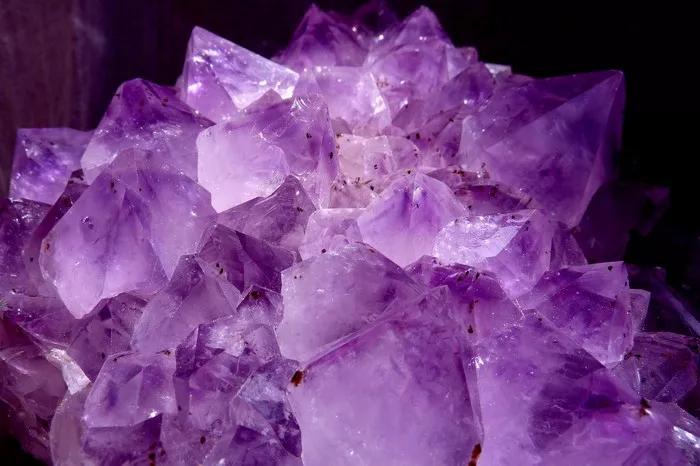Amethyst, with its enchanting purple or violet hues, has captivated humanity for centuries. From ancient civilizations to modern jewelry enthusiasts, this gemstone continues to hold a place of prominence. However, with the popularity of amethyst comes the risk of encountering imitations and synthetic versions. Therefore, knowing how to distinguish real amethyst from its counterparts is essential for gemstone enthusiasts and professionals alike.
In this article, we will delve into the various methods and techniques used to test the authenticity of amethyst. From color examination to hardness tests, we will equip you with the knowledge needed to confidently identify genuine amethyst gemstones.
Color Examination
Amethyst’s defining characteristic is its captivating purple or violet hue. When assessing the color of a purported amethyst gemstone, one must pay close attention to its predominant shades. Authentic amethyst typically exhibits a rich purple coloration, though some variations may feature subtle reddish undertones.
One method of discerning authentic amethyst is through the observation of color zoning. This phenomenon refers to the uneven distribution of color within the gemstone. When placed on a white surface, genuine amethyst may reveal distinct zones of varying intensity or saturation. This natural occurrence lends credence to the gem’s authenticity, as synthetic or imitation stones often lack this complexity in color distribution.
Clarity Assessment
In addition to its enchanting color, authentic amethyst is renowned for its exceptional clarity. When scrutinizing a purported amethyst specimen, one should strive to identify any visible inclusions or imperfections. Genuine amethyst gemstones are typically “eye-clean,” meaning they are devoid of any noticeable blemishes or trapped materials.
Bubbles and discolorations are rare occurrences in authentic amethyst, serving as red flags when encountered during examination. These anomalies are more commonly associated with synthetic or counterfeit stones and should prompt further scrutiny.
Cut Inspection
The art of gemstone cutting plays a pivotal role in enhancing the beauty and allure of amethyst. Authentic specimens can be found in a myriad of shapes, including round, pear, square, and heart cuts. The ease with which amethyst can be cut allows artisans to experiment with various faceting styles, resulting in a diverse array of designs.
When assessing the cut of a purported amethyst gemstone, attention should be directed towards its smoothness and polish. Authentic amethyst exhibits a flawless finish, with no rough edges or uneven surfaces. In the case of round-cut stones, a consistent color distribution throughout the gem serves as a testament to its authenticity.
Imperfections and Consistency
Contrary to popular belief, imperfection is a hallmark of authenticity when it comes to gemstones. Genuine amethyst gemstones often display subtle variations in color and tone, reflecting the natural processes that govern their formation. Shades of white or blue, interspersed with the predominant purple hues, contribute to the gem’s inherent beauty and uniqueness.
During examination, one should scrutinize the surface of the gemstone for any indications of wear or tear. Authentic amethyst may exhibit minor imperfections, such as surface scratches or abrasions, which are indicative of its natural origin. Additionally, the presence of bubbles, cracks, or other irregularities further corroborates the gemstone’s authenticity, as these features are seldom encountered in synthetic or counterfeit counterparts.
Additional Tests (Optional)
While the aforementioned methods are effective in testing the authenticity of amethyst, there are additional tests that can provide further confirmation.
Hardness Test: Amethyst registers a solid seven on the Mohs scale of mineral hardness. To perform this test, attempt to scratch the surface of the gemstone with a material of known hardness. Genuine amethyst should be able to scratch anything softer than itself.
Magnifying Glass Test: Use a magnifying glass to examine the amethyst up close. Compare its features with online images of authentic amethyst gemstones to identify any discrepancies or irregularities.
Table Cloth Test: Lay the amethyst gemstone on a white table cloth. Genuine amethyst is unlikely to lay perfectly flat, as it may exhibit slight imperfections or irregularities in shape.
Heat Test: Hold the amethyst gemstone with tweezers over a candle flame. Genuine amethyst is resistant to heat and will not melt under normal conditions.
Conclusion
In conclusion, testing the authenticity of amethyst gemstones requires a thorough examination of various factors, including color, clarity, cut, and imperfections. By utilizing the methods and techniques outlined in this article, gemstone enthusiasts can confidently identify genuine amethyst specimens and distinguish them from imitations or synthetic alternatives. Whether you are a collector, jeweler, or simply an admirer of these captivating gemstones, possessing the knowledge to discern real amethyst is invaluable in ensuring the integrity and authenticity of your collection.


